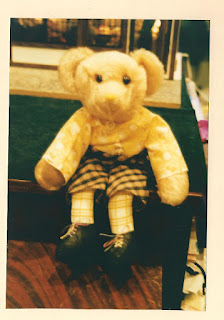It is weather for hot water bottles and covers for them are really easy to knit.
Bottles vary quite a bit in size so it is better to knit a cover to fit your bottle.
With your chosen yarn, needles and the stitch pattern you are going to use, knit a sample to establish your guage.
Now measure your bottle across and cast on enough stitches for that (with one or two extra for ease if your stitch is one of the less elastic ones.)
Work a buttonhole band placing your buttonholes where you want them, and making them the size to fit your buttons. I recommend 4 flat buttons as this keeps the flap closed and is not uncomfortable. Work band until it is wide enough to take your buttons. Leave this piece on a spare needle.
Now cast on the same number of stitches and work the same width of band for the buttons to go on. Then change to your main stitch and work a few centimetres.
Then you need to decrease at both sides to accomodate the bottom curve of the bottle. You can work straight but it looks better if you treat it like the shoulder of a garment. Make a note as you go of what you have done!
When you are happy with that continue, but this time increasing the same number of stitches that you previously decreased until you have your basic number of stitches again.
Continue straight until you have reached a point level with the start of the button band. Now you can change to knitting in the round. (There are ways of doing the bottom section in the round too but they are a bit fiddly so I don't usually bother.)
Overlap the two bands you made and when you get to the end of a row just carry on across the stitches you left on a spare needle. You can either continue in the round or, if you only have straight needles, just go back and forth across the whole width (at least you will have one fewer seam to do).
Continue straight to the start of the bottle's shoulders. Here you decrease at both sides again as for shoulders. You can go back to working the 2 sides separately at this point if it is easier.
Once you have got to the start of the neck I recommend some sort of ribbing. Work enough for a polo neck for the bottle. Cast off reasonably loosely.
Sew on the buttons. Sew up any remaining seams. Insert the bottle through the buttoned opening.
Keep warm!


















































